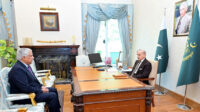Pakistan is a unique country that has a prominent place among the countries where there are hundreds of archeological and historical sites. The historical sites, the northern areas, the touching places and much more make this land unique.
If we talk about the city of Lahore, it is said that he who has not seen Lahore was not born. People go to Lahore at least once in their life thinking that dying without seeing Lahore is tantamount to not coming into the world. Lahore has a rich and varied, albeit rather obscure, history. Historians are still unsure whether when the city was established, with estimates ranging between 2,000 and 4,000 years ago.
Lahore is famous for its chit-chat food and historical sites and anyone who goes to Lahore must see these places, however, there are some anonymous places in the city which are historically important but Lahore itself will know very little about them.
Let’s see what those places are…
1. The Temple of Lava – Lahore Fort
Tucked away in a room in the Lahore Fort, is the Temple of Lava which was dedicated to the son of a Hindu deity, Lord Rama Chandra who is the founder of Lahore city & Lahore Fort. Its origins remain shrouded in mystery.

According to Hindu Mythology, the name of Lahore city is attributed to his son, Lava. This temple is located inside the Alamgiri Gate of Lahore Fort which is very near to the Royal Kitchens.

2. The Tomb of Cypress
This mausoleum belongs to Begum Sharf-un-Nisa, more commonly known as Saru Wala Maqbara, who has been described by some historians as the famous historical figure Anarkali. Saru means cypress in Urdu and it is named this way because large cypress trees can be seen from afar on the ceramic tiles on the tomb.

The tomb is located in the Begumpura area. According to some historians, the tomb was built for the sister of Nawab Zakariya Khan, who was the governor of Lahore during the reign of Muhammad Shah, in 1745.
Five Retreats in Mountains Like Glamp Camps

3. The Tomb of Khan-e-Jahan Zafar Jang Kokaltash
This tomb belongs to Zafar Jang Kokaltash, a valiant soldier of the Mughal emperor Aurangzeb. The tomb is located near Larechs Colony Mughalpura on Canal Road, Lahore. Aurangzeb deposed Khan Jahan Bahadur in June 1693, later he died in Lahore on November 23, 1697 and the tomb was built immediately after his death. Like many other historical sites, this tomb is in a state of disrepair.

4. Gulabi Bagh Gateway
Traveling from the University of Engineering and Technology (UET) to Shalamar Bagh, on the left side of the road, in a cluster of shops and workshops, one can see a masterpiece of architecture. However, the building, known as the Gulabi Bagh, laments its neglect due to the negligence of the Archaeological Department.

Top 5 Most Beautiful Lakes in Pakistan That You Must Visit
According to historians, it was built by Mirza Sultan Baig in 1656. Historians write that passers-by were amazed to see the magnificent and ornate porches built around the four corners of the vast Gulabi Bagh. This gateway also leads to Dai Anga’s tomb, the wet nurse of Emperor Shah Jahan.

5. The Mosque of Mariyam Zamani Begum
The mosque was built by Maryam Zamani Begum, wife of Mughal King Akbar and the mother of Shah Jahan in the early 17th-century (between 1611 and 1614). In history, this woman was also known as Jodha bai. This mosque is located inside the walled city of Lahore on eastern side of the Lahore Fort.

6. Haveli of Nau Nihal Singh
This lofty haveli is reckoned among the most magnificent buildings of Lahore which belongs to Nau Nihal Singh, the grandson of Maharaja Ranjit Singh. The mansion located inside Bhati Gate is beautifully decorated with glass which preserves its original ornamentation and architecture.

Eight Essentials to Bring on a Road Trip
There are magnificent mirrors and masterpieces of painting on the walls, some of which were made of gold. It was built in the Sikh era in the middle of the nineteenth century (around 1830 or 1840) and is considered to be one of the finest examples of Sikh architecture in Lahore.

7. The Tomb of Ali Mardan Khan
Ali Mardan Khan was a Kurdish general in Shah Jahan’s army and a former governor in the region. Khan governed the areas of Kashmir, Lahore and Kabul in the mid-1600s. His mausoleum is located behind the fruit market at Shalimar Road near Gulabi Chowki in Mughalpura, Lahore. The large, lovely, octagonal brick tomb was originally built around the 1650s.

Stay tuned to Baaghi TV for latest news, updates and exciting content!






